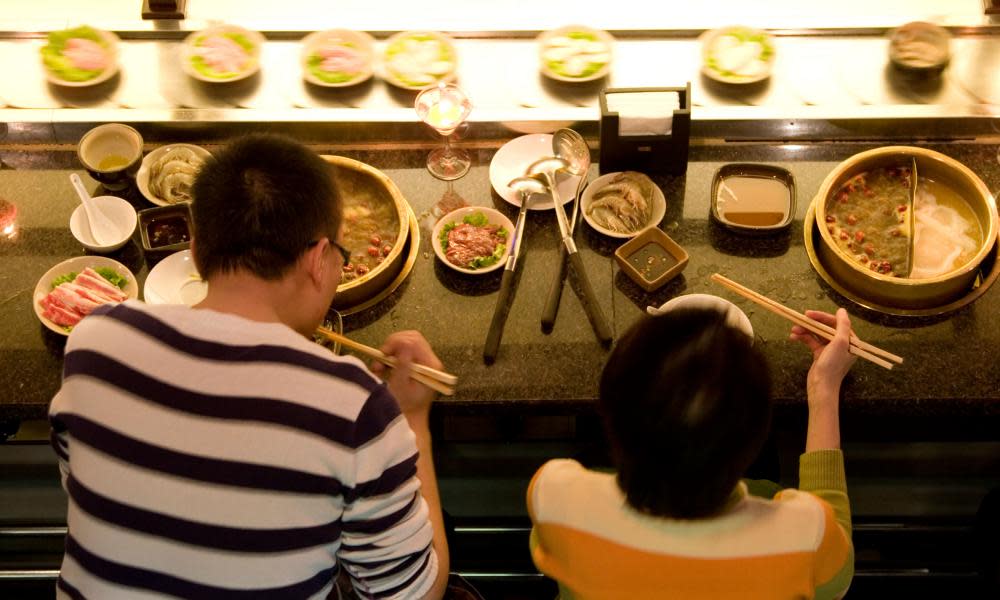China's 'dining table revolution' takes aim at shared chopsticks

On 18 January, about 40,000 families in the neighbourhood of Baibuting in Wuhan gathered for a massive potluck meal before the Chinese new year. Photos of the annual event, proudly published in local state media, showed residents in festive red and yellow bibs digging in, reaching with their chopsticks for hundreds of dishes laid out on banquet tables.
Five days later, the city was placed under lockdown and within weeks, there were several possible coronavirus infections in the neighbourhood. For months to come that banquet would be cited as an example of how little local officials had done to prevent the virus from spreading across their city.
In the aftermath of the coronavirus outbreak, Chinese authorities are pushing for a “dining table revolution” to change long-held traditions of communal eating like those on display at the Baibuting meal, where diners take from shared plates with their own chopsticks.
Authorities have launched an aggressive campaign to convince diners to use designated serving utensils known as gongkuai or gongshao, or “public chopsticks” and “public spoon”. Officials are also encouraging the serving of separate portions rather than “family style”, where a group shares several dishes.
It will be a difficult feat to pull off. After the 2002-2003 Sars epidemic, a similar initiative petered out. More challenging is that sharing food is a key part of Chinese social life and a sign of intimacy.
The gongkuai – more common in Japan, Korea or Taiwan – tend to be seen at higher-end restaurants in China and rarely used at home. Among family or friends, asking for the serving utensils can be awkward or perceived as rude.
“The obstacle is the traditional notion that we have to drink together and eat together and not show any distance,” said Q. Edward Wang, the author of Chopsticks: A Cultural and Culinary History. “That kind of notion is well entrenched in Chinese society as well as around the world,” he said.
Under proper chopstick etiquette, taught at an early age, one should touch only the food that they intend to take and not mine the shared dishes. But Chinese health officials say the practice leaves too much opportunity for germs to be passed through saliva from one’s own set of utensils to the shared dishes.
Authorities believe sharing meals was one way the virus was passed on in China, especially among families that accounted for 85% of infection clusters in Guangdong and Sichuan province, according to the World Health Organization.
Across the country, celebrities, business tycoons, public health experts, and teams of propaganda workers have been deployed to educate the public. “Divide meals, not love,” state media have declared.
In Ningxia in north-west China, a video tutorial by local state media tells residents in local dialect of a “new trend in civilised dining”.
“Dividing meals and chopsticks is not dividing love,” it assures viewers. In Hangzhou, a local party member has called for 11 November to be designated “People’s Chopsticks Action Day,” given the date’s similarity to two sets of chopsticks.
In Beijing, billboards call for citizens to join the campaign under the tagline: “Love is one more pair of chopsticks.” Starting in June, restaurants will be required to provide serving utensils and when possible to offer separate portions.
The campaign appears to be working at restaurants. A manager at the Tianzhu chopstick factory in Zhejiang province told the Guardian the company has seen orders for gongkuai, which are longer and decorated differently, go up as much as 30%.
At Huajia Yiyuan, a chain known for its Beijing roast duck, each place setting has two pairs of chopsticks and two spoons. At a popular hotpot restaurant on Beijing’s Ghost Street, all tables come with a set of the serving utensils. “Customers are very willing to use them,” said Lan Luoshi, 20, who works there. “If I go out with friends to eat or for hotpot, I will definitely use gongkuai,” she said.
Changing habits at home and among the older generation may be harder. A common scene at family dinners involves relatives using their own chopsticks to put food on the plates of younger members of the family. Younger family members serve food to their older relatives as a sign of respect, while couples get food for each other in a show of affection.
Many don’t regard using the designated serving utensils as necessary at home. In a recent online poll by Sina Shanghai, half of more than 650 respondents said they would not use gongkuai or gongshao at home, agreeing with the response: “I won’t. We are all one family.”
Chinese eating culture may be changing in other ways, away from crowded, bustling restaurants to quieter affairs. Many restaurants limit the size of dining parties to two and place tables at least 1 metre apart.
Shi, 50, a chef at a noodle shop in a mall in Beijing’s Chaoyang district says he and his wife now rarely invite friends over. He recently noticed a group of co-workers come into his restaurant and naturally split into smaller groups, eating at separate tables.
“The epidemic has already changed big things,” he said. During Chinese new year in late January, authorities called on residents not to visit families, a key tradition for the holiday. “If the outbreak can change that, changing how we use chopsticks is nothing,” he said.
According to Wang, it took several hundreds of years for chopsticks to become the staple utensil. Changing modern eating habits, while difficult, should not take as long. “Customs are much more powerful than policy,” he said.
“The pandemic and the government directives will provide some impetus. Gradually people will become more adjusted to the idea that even if we don’t share food, we are still friends.”
Additional reporting by Lillian Yang

 Yahoo News
Yahoo News 
